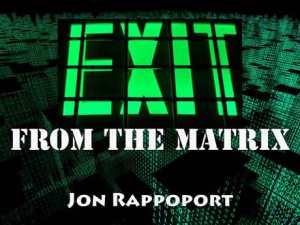by Jon Rappoport
October 23, 2019
(To join our email list, click here.)
“The last time we saw her, him, or it, the winged figure, there were great shapes scrawled in the sky left behind, and then a single thought slowly falling to Earth like a light snow. The thought was: if these sky shapes had meaning, what would it be? And if each of you could decide independently, what would happen?” — Auntie Mime, Reality Disruptor
“The only menace is inertia.” — St. John Perse
The red knight said to the blue knight, “I’m departing for unknown shores. Here I give you the seal of my empire. Hold it close. When the hour of the new year strikes, open it and view the symbol contained therein. It carries esoteric meaning that will usher you into my lands.”
The blue knight was staggered. “Is this really true?” he said.
“I’ll reply with a riddle. Listen. It’s true if you’re a fool.” — Auntie Mime, Reality Disruptor
In land far-far or near-near, the people had symbols. For many centuries, symbols had been imposed on them.
This is not a hard thing to do. For example, you build a tower and place art around the joint and you play droning music and you dim the lights and you hold services, and the high priest hopefully has a rich mellow voice, a good baritone…and at the appropriate moment, he lapses into silence, waits, and then leans forward and pronounces the name of the symbol…maybe he holds up an illuminated stick with the symbol at the end.
Then he describes the meaning of the symbol.
And it sinks in.
Squish.
With enough time, enough good prep, enough symbols, you can put a whole populations under hypnosis and lead them around by their collective nose.
Well, in this land, the people eventually got tired of that crap, and so they sank the tower in the sea and started over.
From that moment on, symbols were OPEN.
Symbols were contemplated, now and then, and people could derive (imagine) whatever meanings they preferred. Each person could do that.
Then they would hold informal meetings, and after a few comedians loosened things up, people would stand, one at a time, and present their experience with the symbol of the month. Do their riffs. The only rule—don’t be boring.
The funny thing was, after a few years of this sort of meeting, the very language of the people began to expand…new words, new phrases, new ideas, new images…even new constructions.
It was a language, more and more, infiltrated by imagination.
And what do you know, the people became freer and more energetic. They sensed their language was coming into line with their creative impulse—whereas in many societies, the creative impulse comes into line with the language.
The people called this a major discovery, and they celebrated it by building a new tower. They discussed what to call it. After a few days, they said HOLD ON, THIS IS RIDICULOUS, and burned it down.
Every year, they build a new tower and burn it.
Just to remind themselves about what can happen when everyone behaves like an android and allows meaning to emanate from one point.
Their language is now 1000000000 times its former size.
Oh, off in a corner of a dim bar, a few guys reminisce about the good old days when things were normal and they knew what “the spiritual universe” consisted of. They wish it would all come back. The music, the snoring, the hypnotic ceremony, the closed symbols. They really love those closed symbols.
They’re even trying to build their own permanent tower out at the end of town by a tire recapper and a collapsed warehouse. Others, of the new generation, will go down there on a Saturday morning, stand around, and chip in advice.
“Put more mud on that side.”
“Make the holes for the windows a little bigger.”
Much amusement.
One universe, many universes, take your pick.
(To read about Jon’s mega-collection, The Matrix Revealed, click here.)
Jon Rappoport
The author of three explosive collections, THE MATRIX REVEALED, EXIT FROM THE MATRIX, and POWER OUTSIDE THE MATRIX, Jon was a candidate for a US Congressional seat in the 29th District of California. He maintains a consulting practice for private clients, the purpose of which is the expansion of personal creative power. Nominated for a Pulitzer Prize, he has worked as an investigative reporter for 30 years, writing articles on politics, medicine, and health for CBS Healthwatch, LA Weekly, Spin Magazine, Stern, and other newspapers and magazines in the US and Europe. Jon has delivered lectures and seminars on global politics, health, logic, and creative power to audiences around the world. You can sign up for his free NoMoreFakeNews emails here or his free OutsideTheRealityMachine emails here.

